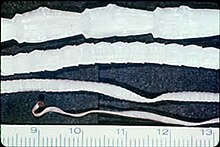Neodermis
The neodermis or the tegument is a "secondary body covering" in the members of the neodermata , to which the tapeworms (Cestoda), the hooked worms ( Monogenea) and the suction worms (Trematoda) belong, as well as the scratch worms (Acanthocephala).
Neodermis of the Neodermata

The neodermis is formed from cells of mesodermal origin and replaces the original epidermis . This happens through larval already existing mesoderm tissue, which pushes through runners under the epidermis and detaches it. The individual cells of the neodermis then fuse to form a uniform tissue without cell boundaries, which is known as the syncytium and in which the cell nuclei lie further inside the body, below the basal matrix . The formation of the neodermis takes place when the first larvae develop into a first parasitic form.
Tegument of the Acanthocephala

In the very large species, the tegument can be up to two millimeters thick and, like many other tissues in these animals, is formed by a syncytium . In most species, the basis of this cell network is formed by around 6 to 20 individual cells, the adjacent cell membranes of which dissolve and thus form a group-specific tissue with many small or significantly less very large cell nuclei. The cell nuclei enlarge in the course of development and become polyploid through constant mitoses ; in many species they branch out and reach a diameter of up to two millimeters. Especially in large species, the cell nuclei disintegrate into many small fragments without mitotic division. In the epidermis, there are also collagen fibers , which on the outside predominantly run parallel to the direction of the body and in the lower layers in a ring and thus stabilize the epidermis. The outermost area is denser than the inner one, but does not form an armor. This layer is criss-crossed by numerous invaginations, which form a complex lacunae system that is used for nutrition.
supporting documents
- ^ Willi Xylander : Neodermata. In: W. Westheide, R. Rieger (Ed.): Special Zoology. Part 1: Protozoa and invertebrates. Gustav Fischer Verlag, Stuttgart / Jena 1996, ISBN 3-437-20515-3 , p. 230 ff.
- ^ Sievert Lorenzen: Acanthocephala, scratches. In: Wilfried Westheide , Reinhard Rieger : Special Zoology. Part 1: Protozoa and invertebrates. Gustav Fischer Verlag, Stuttgart / Jena 1996, ISBN 3-437-20515-3 , pp. 723-728.